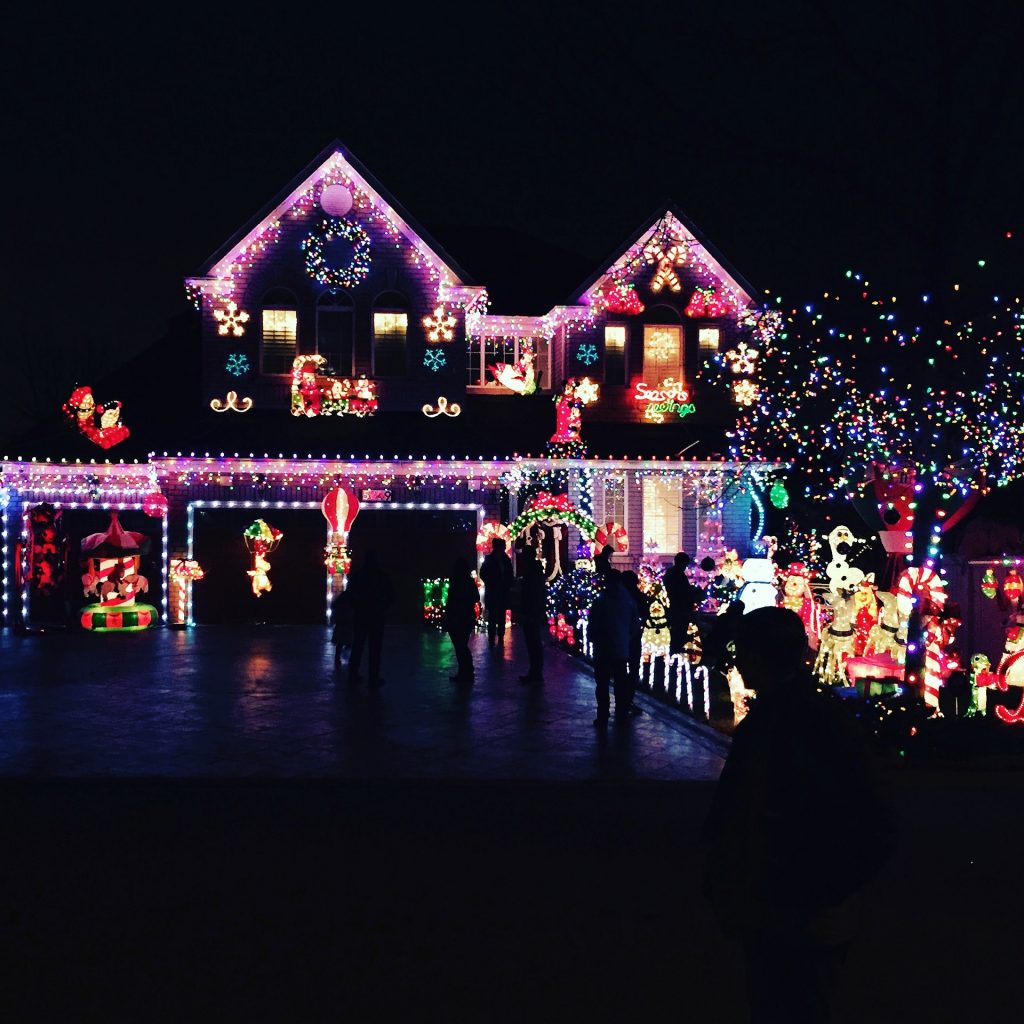Some Christmassy thoughts from Perform Green Senior Consultant Becki Clark
Deck the halls, it’s Christmas time, and you know what that means. Mince
Map the Halls

Way back when my family and I had a particular – and looking back, peculiar – Christmas tradition. We would get in the car, drive to a random town, get out and walk around looking at the Christmas displays that people had on their houses. The flashing lights and excitement of what might be around the next corner are as Christmassy to me as the mulled wine and Wham combo is now. Forget tinsel and baubles; for us Christmas was bright indeed, animatronic if possible and ASBO-awardingly obnoxious.
Now I’m all grown up, I can still be found treasure hunting, making maps of my local area. Maps are an especially great communication tool; they can be easily understood by both a local and a person new to the area, and they can be adapted or drawn to show almost anything you can think of. I use them to talk about energy systems; they are particularly powerful at showing connections.
You can use a very simple digital technology to get out and about in your local space and find local resources – it’s the map on your phone. Google maps in particular is big on using Local Guides, people who – for free – rate and review services and businesses that they visit and gain ‘points’ as a reward (hands up – I’m one of them). Google Map contributors can suggest new places, add photographs of products and food, but of course once you hand over your images they aren’t yours anymore. But what about things which just aren’t there for long, or things that you might not realise are there, and – sorry about this dark turn, and at Christmas too – wouldn’t even miss them if they were to vanish?
Gotta Catch Them All!
Parks and greenspace is a good example. Treepedia is a project by MIT Senseable Labs to map all the trees in an urban area. This cool project uses computer vision techniques coupled with Google Street View images to map the tree canopy of more than 25 cities around the world. Now, they are releasing an open-source version of the code which will allow anyone to compute the GreenView Index (GVI) of their own metropolis or region. (You can access their open-source Python library to get started and discover how your city compares with others across the globe when it comes to tree distribution).
But why should the computers have all the fun?
The Jenni and Laura have created the Sheffield Park Project – they have mapped all the green spaces in Sheffield and are going to visit them all in 2018/19. On the map below, those they have visited are green, and red are yet to go)
A fun project like this is helping people find hidden gems, pockets of quiet and peace in the city, and a place for city dwellers to connect with the natural world.
Speaking of nature, I’ve always believed that if you don’t realise it’s there, you won’t miss it when its gone. Just think about when you had to scrape insects off your numberplate in the summer; now we hardly have to do that at all. Our wildlife is declining at a rapid rate, but we just don’t care if we don’t know what’s there to miss. However, ask any child (around 4-10) about which Pokemon is their favourite and where they can be found, and you will be surprised at how informed they are.
Pokemon Go is the popular mobile game based on the Nintendo franchise. Developed and launched by Niantic, they use a Real World Platform to present an augmented reality game which is arguably the world’s most important game. That’s not to say it has been all great – some of the locations of the in-game items have been inappropriate, and the huge in-person game events have been plagued with mobile network issues – but they are innovating and learning, and importantly getting people out to move and interact with the real world. It uses a baseline map with analytics from another of their games to determine where people congregate, meaning that they build their social meeting spaces where people meet anyway in the real world. The game also involves collecting one of each species of Pokemon, boasting a library and a personalised index (PokeDex) which records your interactions with the monsters. The idea is there; it is a small step toward building something to collect sightings of real British animals, birds, trees and more.
Getting people to move more and navigate their city through encouraging play is starting to take hold. This summer I found my city of Gloucester peppered with little boxes which, when swiped with a free card you could get from the library or council, would make a little noise and give you points. Beat the Street turns towns into giant games. Although these points weren’t worth a thing in real monetary terms to an individual, that strange human instinct to collect things and see how many you can get took over. The placement of the boxes were such that they encouraged you to find little cycling and walking rat runs between the two, optimising your routes and expanding the repertoire of routine places you visit. I found small parks and greenspace, new-to-me little alleyways with cute shops, and other players happily tapping their cards and fobs on the boxes to win points for their schools and community groups. Run by Intelligent Health, the company uses the game to promote physical activity, active travel, mental health, social cohesion and address inequalities. Phew! That’s a lot for one game to handle, but perhaps approaching problems in the spirit of fun is the way to go to open up the conversation? And does it work? “Key findings showed that participants increased their weekly walking by 180 minutes per week and their overall levels of physical activity by 335 minutes per week”, their website says.
Move More in Sheffield is another example, where instead of a game the local authorities and public services (NHS, Sports Centres, Universities) aim to turn Sheffield into a Move More culture and the most active city in the UK by 2020. This maps out 6 keys areas of work into how to make physical activity part of your day; commuting to work, school or NHS treatment; socialising through sport; and more. They will do this through social media and activities to show people how easy it is to incorporate movement into their day to day lives. I like the idea, as studies show that you are likely to follow the habits of your social group and what ‘normal’ is, and this might just raise the profile of movement as a ‘normal’ day to day activity enough to tip the balance.
Shazam for bird song
Gamification and use of augmented reality might be the saviour of our community and natural resources, as well as promoting health. Individuals don’t have to wait for huge programs or game releases to get involved; I map things I cannot find on a traditional online or paper map like blackberry bushes, community apple orchards, outdoor gyms and those seasonal Christmas decorations using the ‘Saved’ feature on Google Maps to save to a list. I share the list, and as well as showing others the locations I’ve pointed out it presents it as a checklist that you tick off as you visit each location. It’s a treasure hunt, using digital technologies to get people out and about in their community and find resources they can use time and again (play parks and gyms) or seasonally (blackberry patches and Christmas decorations).
There are excellent apps for engaging with the natural world to ‘collect’ species like you do in Pokemon Go, picking up knowledge and understanding rather than pixels. Leafsnap UK identifies tree species from its leaf; Warblr is Shazam for birdsong and identifies birds from a clip of birdsong that you record.
Perhaps a New Year’s resolution for your family could be to use augmented reality to engage with the natural world more; you know it’s good for you, and it’ll be good for local
If you happen to be in the Gloucester area, why not visit some of the Christmas displays I have mapped here.
But for now, wrap up warm, grab the kids and your phone, and go pretty hunting. Share your maps with us here!
Merry Christmas!
